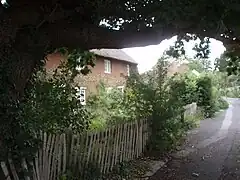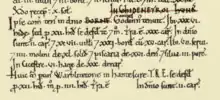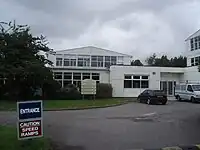| Warblington | |
|---|---|
 An older house in Warblington, which was partly destroyed by fire in May 2011 | |
 Warblington Location within Hampshire | |
| OS grid reference | SU725065 |
| District | |
| Shire county | |
| Region | |
| Country | England |
| Sovereign state | United Kingdom |
| Post town | HAVANT |
| Postcode district | PO9 |
| Dialling code | 023 |
| Police | Hampshire and Isle of Wight |
| Fire | Hampshire and Isle of Wight |
| Ambulance | South Central |
| UK Parliament | |
Warblington is a suburb of Havant, a town in Hampshire, England. Warblington used to be a civil parish, and before that was part of the Hundred of Bosmere.[1]
Etymology
In Saxon times there was a farm (OE: tun) possibly owned by a woman called OE: Wæ̃rblið who gave her name to the village.[2] There are some alternatives eg: 'the farm (OE: tun) of Wæ̃rblealds'.[3]
The current Warblington Castle Farm occupies the approximate site of the original farm.[2]
History
Pre-Roman
In prehistoric and early historical times the River Ems was tidal as far as Westbourne and the Westbrook creek reached to Victoria Road, leaving Emsworth almost isolated at high tide. A coastal route developed that led from Hayling Island through Havant and Rowlands Castle to the South Downs. A part of the coastal route followed the Portsdown ridgeway and from Chichester to Belmont Hill in Bedhampton probably skirted the heads of the various creeks which entered the harbour, passing through country still covered with the original thick forest of oak and beech.[4]
Roman
In Roman times a villa existed to the south of the road to Noviomagus Reginorum in the fields of what is now Warblington Castle Farm. Archaeological finds show that the building was a sizeable brick and stone edifice, with floors paved with red brick and coloured sandstone and a view of the harbour and wooded shores of Hayling Island. The fertile landscape suggests the area to have been under continuous cultivation for 1500-1800 years.[4]
Anglo-Saxon
After the departure of the Romans, Warblington became part of Meonwara, an area that was settled by Jutes and according to the Venerable Bede :
" Those who came over were of the three most powerful nations of Germany—Saxons, Angles, and Jutes. From the Jutes are descended the people of Kent, and of the Isle of Wight, and those also in the province of the West Saxons who are to this day called Jutes, seated opposite to the Isle of Wight."
— Bede 1910, 1.15
In the 7th century Meonwara was absorbed into the Kingdom of Wessex and Saint Birinius converted Wessex to Christianity. In Warblington the Anglo-Saxons constructed a church where they could worship. The current St Thomas à Becket Church, Warblington occupies the same site as the old church and still retains some elements of the old structure.[5][6][7]
Charters were granted by Kings Æthelstan and Æthelred in AD 935[lower-alpha 1] and 980[lower-alpha 2] establishing and confirming boundaries of Warblington.[8] From AD 980-1066 the manor was held by Godwin, Earl of Wessex and his son Harold Godwinson.[9]
Medieval

After the Norman Conquest, the Manor of Warblington was given to Roger de Montgomery, Earl of Shrewsbury as part of the manor of Westbourne. The Domesday Book lists the latter with two churches (one of the churches was actually at Westbourne), a mill, 29 families and two slaves (about 120 people). There were also seven plough teams, indicating about 850 acres of land under cultivation.[10]
In the 1400s, the people were removed and the area became a private deer park for Richard Neville, 16th Earl of Warwick who then owned the manor.[11]
The village originally was the site of a moated manor, built between 1515 and 1525, by Margaret Pole, Countess of Salisbury. The building, now known as Warblington Castle, was mostly destroyed, in 1644, during the English Civil War. All that remained was a single gate tower, part of a wall, and a gateway.[12][13]
Modern
The Imperial Gazetteer of 1870-1872 described Warblington as having a population of 2,196 as of 1861 and mentioned that the "church is Saxon".[14]
The parish church of St Thomas à Becket is part of a joint parish with the church of St James, Emsworth.[15] The oldest part of the church is the small central tower, which is Saxon and was built in the 11th century. In 1967 Pevsner and Lloyd described St Thomas à Becket church as essentially late 12th century and notes the "undisturbed" setting. To the north of the church is the locality's most distinctive landmark: the tall octagonal turret of Warblington Castle. In October 1551, Mary of Guise the widow of James V of Scotland stayed a night in Warblington manor as a guest of Sir Richard Cotton.[16]
A cemetery, the ruins of Grade II listed Warblington Castle, on private property, the Grade I Listed St Thomas à Becket Church, Warblington[17] a Grade II listed Old Farmhouse,[18] and the Grade II listed Old Rectory[19] are all within the boundaries of the Warblington Conservation Area.
Warblington contains a large secondary school (Warblington School) but no primary school.[20]
Warblington railway station is on the West Coastway line.
Green Pond Corner used to be the local pond. The "corner group" also included Warblington House and Warblington Farm according to records from 1870.[21] The pond was covered over around 1920 and now hosts the One Stop corner shop and local glass and fabric recycling point.[22]
Notable residents
- Sir Peter James Blake KBE (1 October 1948 – 5 December 2001), Sailor, buried in Warblington cemetery
- John Brown (1820 – unknown), cricketer born in Warblington
- George Carter (1846 – unknown), cricketer
- James Norris, President of Corpus Christi College, Oxford 1843–72
Notes
- ↑ S.430. A.D. 935. King Athelstan to Wihtgar, minister; lease, for four lives, of 7 hides (mansae) at Havant, Hants. [8]
- ↑ S 837. A.D. 980. King Æthelred to the monks of Old Minster, Winchester; grant of the reversion of 7 hides (cassati) at Havant, Hants., which had been granted by King Athelstan to Wihtgar, his thegn, for four lives (cf. S 430). [8]
References
- ↑ "Warblington". Genuki.
- 1 2 Reger 2016, p. 17.
- ↑ Ekwall 1991, p. 497.
- 1 2 Reger 2016, pp. 19–21.
- ↑ Reger 2016, pp. 25–26.
- ↑ Yorke 1995, pp. 36–43.
- ↑ Yorke 1995, pp. 171–176.
- 1 2 3 KCL 2022.
- ↑ Brandon 1978, p. 211.
- ↑ Powell-Smith 1086.
- ↑ Lloyd 1974, p. 23.
- ↑ Barron 1985, p. 50.
- ↑ Hampshire Gardens Trust 2001.
- ↑ Vision of Britain 2016.
- ↑ Parish of Warblington with Emsworth 2022.
- ↑ Turnbull 1861, pp. 188–299.
- ↑ Historic England. "Church of St Thomas-a-Becket (Grade I) (1154443)". National Heritage List for England.
- ↑ Historic England. "Warblington Castle Famhouse (sic) (Grade II) (1091613)". National Heritage List for England.
- ↑ Historic England. "The Old Rectory (Grade II) (1303444)". National Heritage List for England.
- ↑ Lewis 2022.
- ↑ HCC 2022.
- ↑ One Stop 2022.
Bibliography
- Barron, William (1985). The Castles of Hampshire & Isle of Wight. Paul Cave Publications. p. 50. ISBN 0-86146-048-0.
- Bede (1910). . Translated by Jane, L. C.; Sellar, A. M. – via Wikisource.
- Brandon, Peter, ed. (1978). The South Saxons. Chichester: Phillimore. ISBN 978-0-85033-240-7.
- Ekwall, Eilert (1991). The Concise Oxford Dictionary of English Place Names (4 ed.). OUP. p. 497. ISBN 0-19-869103-3.
- Hampshire Gardens Trust (2001). "Warblington Castle". Hampshire Gardens Trust. Retrieved 1 March 2001.
- HCC (2022). "Section 6.1.2". Warblington with Emsworth & notes on Rowland's Castle (PDF). Hampshire County Council. Retrieved 13 July 2022.
- KCL (2022). "The Electronic Sawyer". London: King's College London. Retrieved 26 June 2022.
- Lloyd, David (1974). Buildings of Portsmouth and its Environs. Portsmouth: City of Portsmouth. p. 23. ISBN 978-0901559531.
- Lewis, Tandy (2022). "Warblington School". Locrating. Retrieved 7 July 2022.
- One Stop (2022). "One Stop, Warblington". Retrieved 21 July 2022.
- Page, William, ed. (1908). "Warblington". A History of Hampshire and the Isle of Wight. Victoria County History. Vol. III. London: Archibald Constable & Co. pp. 134–139. ISBN 978-0712905930.
- Pevsner, Nikolaus; Lloyd, David (1967). Hampshire and the Isle of Wight. The Buildings of England. Harmondsworth: Penguin Books. pp. 639–641. ISBN 0-14-071032-9.
- Powell-Smith (1086). "Open Domesday: Warblington". Hull University. Retrieved 13 July 2022.
- Reger, A J C (2016). A Short History of Emsworth and Warblington. Booklet Number 6. Hampshire: Havant Borough Council. OCLC 499724544.
- Timmins, G (2007). Warblington: a village history. Havant: Havant Museum.
- Vision of Britain (2016). "Warblington Hampshire". A Vision of Britain Through Time. Archived from the original on 16 March 2016. Retrieved 20 May 2020.
- Parish of Warblington with Emsworth (2022). "Welcome to the Parish of Warblington–with–Emsworth]". Parish of Warblington with Emsworth PCC.
- Turnbull, William B, ed. (1861). "Edward VI: November 1551," in Calendar of State Papers Foreign: Edward VI 1547-1553". London: British History Online. pp. 188–200. Retrieved 23 July 2022.
- Yorke, Barbara (1995). Wessex in the Early Middle Ages. A&C Black. pp. 36–43. ISBN 978-0-7185-1856-1.
Gallery
 1856 etching of castle and church
1856 etching of castle and church Warblington church
Warblington church Secondary School
Secondary School Tennis Club
Tennis Club Level Crossing
Level Crossing
